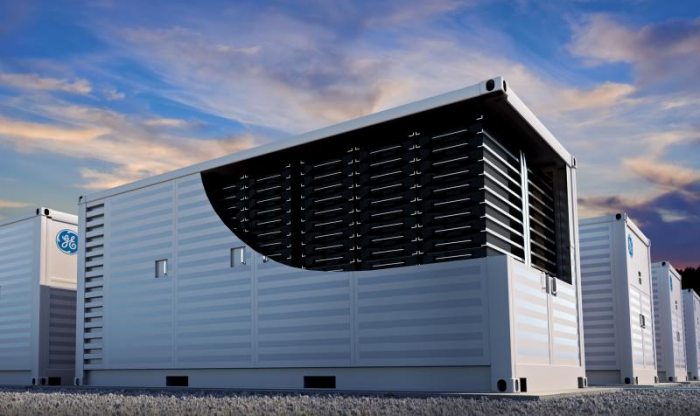Last week, GE unveiled its large-scale energy storage solution, which is based on the 1.2 MW/4 MWh Reservoir Storage Unit.
The lithium-ion battery based GE Reservoir platform can be AC or DC coupled and is designed for various applications including storing energy from solar, wind and thermal generation, and offering services such as peak management, firming, voltage regulation and frequency response.
The modular system incorporates GE’s proprietary Blade Protection Unit (BPU), which the company claims to extend battery life by up to 15% (expected service life is 25 years) and reduce fault currents by up to 5X.
“The energy landscape is undergoing an unprecedented paradigm shift, as the growth of renewables, decentralization of power and digitization create both new challenges and opportunities in how power is generated, transmitted and distributed,” said GE Power’s Russell Stokes. “GE’s Reservoir delivers the new type of energy system that customers are looking for to help manage electricity’s next chapter.”
There’s a bunch of containerised battery storage solutions already available (for example, we mentioned Australian company Redflow’s LSB yesterday), but something that may set GE’s Reservoir apart from the pack is the company also claims up to 50% reduced construction time. This is primarily due to Reservoir Storage Units being shipped with cells already installed.
According to Greentech Media:
“Typically, containerized battery systems ship without the battery cells inside, due to weight, safety or quality concerns. GE bucked the trend by designing a box that can travel with batteries in place but disconnected. A technician with a hot stick can flip a switch onsite to reconnect the electrical circuit and get the system operational again.”
The GE Reservoir brochure can be viewed here. The company expects to start deliveries of Reservoir next year and says it already has a 20MW commitment.
GE will be hoping its foray into large scale storage will help reverse its flagging fortunes. Its share value (NYSE: GE) had dropped from USD $30.27 in April last year to $14.64 just prior to the announcement. Share prices crept up in the days following, only to drop back to $14.27 at close of trade today.
A Big Future For Energy Storage
Late last year, Bloomberg New Energy Finance forecast the global energy storage market (utility-scale and behind-the-meter) will double six times between 2016 and 2030, to reach a total of 125 gigawatts/305 gigawatt-hours. BNEF said eight countries will account for 70% of capacity -and among the top nations is Australia.
Forecasting anything renewable energy related is a pretty tricky business, as renewables have often exceeded expectations. BNEF’s forecast may be quite conservative as significant projects can spring out of nowhere. One recently announced in Australia that springs to mind is a 250MW/650MWh virtual power plant for South Australia.


 RSS - Posts
RSS - Posts



GE uses lithium-ion batteries that last 25 years, pull my finger, April first isn’t for a couple of weeks yet.